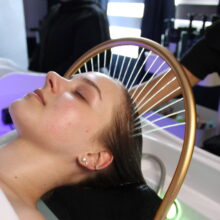Spa Trends 2012 Revisted: Spa Evidence – Showing the Science Behind Spa (Grade “A” for right on prediction!)
- Published: Saturday, November 24th 2012
- in Living Well
In 2011, SpaFinder named “The Science of Spa” a top trend, forecasting a new era where more questions about the proven, medical effectiveness of spa therapies would get asked, leading to new visibility for the growing archive of clinical evidence that exists for approaches like massage, meditation or acupuncture.
With the launch of the new website SpaEvidence.com this year — the world’s first portal to the aggregated medical studies that exists for 21 common spa/wellness approaches — that trend was literally embodied.
Launched by the Global Spa Summit in mid-2011 (an advocacy group for the worldwide spa/wellness industries), and shaped by doctors with an expertise in integrative medicine, SpaEvidence gives the world easy access to the “evidence-based medicine” databases that doctors use, so they can search thousands of studies evaluating which spa modalities are proven to work, and for which exact conditions.
SpaEvidence represented a big, courageous step towards transparency for the spa industry, as the site returns the clinical evidence behind therapies, whether it is positive, inconclusive or negative. And it forged new, common ground between the medical and spa worlds by embracing the rigors of “evidence-based medicine.”
For 2012, we name a trend after this breakthrough website because the “fact” of its appearance so neatly encapsulates a macro shift that is quickening: the continued breakdown of the once separate “silos” of traditional medicine and complementary/spa therapies. And the erosion of these silos, the “Spa Evidence” trend, will take diverse forms in the year ahead…some ongoing, some new.
In 2012, more hospitals than ever before will incorporate — and more doctors will prescribe — spa and wellness approaches, not only because more new research shows that mind-body treatments can be especially effective for chronic pain, heart disease, sleep disorders and depression/anxiety, etc., but because the sheer global costs of not focusing on prevention have passed the tipping point. (Spending on healthcare amongst OECD and BRIC nations will grow 50 percent-plus from 2010 to 2020.[8] )
Consider changes underway in the prevention-challenged U.S. healthcare system: A new study[9] reveals that the number of hospitals offering alternative/spa services has tripled since 2000 (from 14 percent of hospitals, to 42 percent today).
Roughly two in three of these hospitals now provide massage, three in five offer acupuncture and music/art therapy and one in five provide reiki.
Hospitals report footing the bill 44 percent of the time, and at Pritikin (one of the premier weight-loss/heart-health American spa resorts), qualified people now get their trip covered by Medicare.
Another new study[10] finds that of the 41 million Americans that use mind-body therapies like yoga or tai chi, 6.4 million are now doing them because they were “prescribed” by their medical provider.



